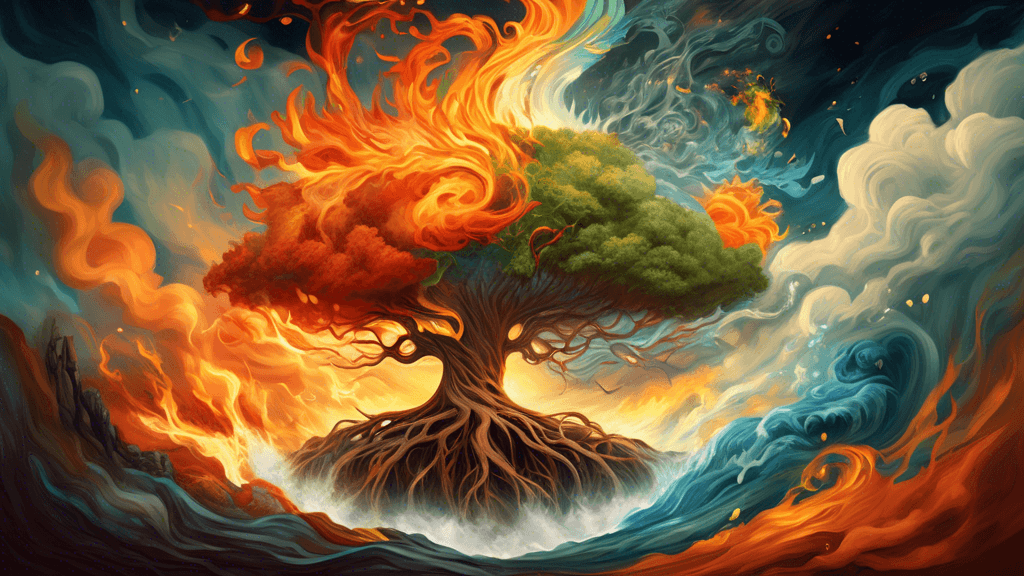
Harmonizing Elements: Earth, Air, Fire, Water in Visual Art
Share
Exploring the Harmony of Elements in Visual Art: Earth, Air, Fire, Water
Visual art has consistently drawn from the natural world for inspiration, employing elements like Earth, Air, Fire, and Water to evoke emotions, convey messages, and create profound connections with audiences. But what makes these elements so significant in the arts? How do artists harness their symbolic power to enhance visual narratives? This blog dives deeply into the integration of these natural forces within artistic expression, uncovering the roles they play in various genres of visual art.
The Symbolism of Earth in Art
The element of Earth is often synonymous with stability, fertility, and grounding. In visual art, it can induce sensations of solidity and permanence, thus providing a foundation for various themes and genres. Consider the use of earthy tones and textures in the works of artists like Ansel Adams, whose black and white landscapes of the American West powerfully connect the viewer to the natural world. The Earth element here does not merely depict topography but also embodies a stoic quality, often evoking a sense of resilience and timelessness.
Air: The Essence of Movement and Freedom
In contrast to the solidifying presence of Earth, Air represents movement, freedom, and the intangible. It can be depicted in the form of a breeze seen rustling through trees, a stormy sky, or the gentle curve of a wind-blown garment. The impressionist paintings of Claude Monet, where light and air play across the surface of landscapes and scenes, provide a poignant example of this element at work. Monet's ability to capture the essence of atmospheric conditions showcases how Air can be used to convey a sense of impermanence and change.
Fire: The Dynamic Transformer
Fire, often associated with energy, transformation, and passion, serves as a powerful tool in the artist's palette. It can symbolize destruction as well as renewal, serving as a dual metaphor depending on the context of the artwork. Francisco Goya's The Forge powerfully captures the intense and almost primordial scene of blacksmiths working with molten metal, using Fire not only as actual light and heat but as a symbol of human industry and creativity.
Water: Depth and Reflection
Water, with its fluidity and clarity, is perhaps the most versatile of the elements in its symbolic capacity. It can represent cleansing, danger, mystery, or depth. The reflective qualities of water provide artists with a literal mirror to explore themes of reflection, both visual and psychological. Renowned modernist painter Georgia O’Keeffe frequently utilized water motifs to explore depth and surface in her abstract works, presenting Water not just as a substance, but as a portal to different realms of perception.
Integrating Elements for Artistic Expression
The interplay between Earth, Air, Fire, and Water in visual art goes beyond the mere representation of nature. It taps into a deeper narrative, an abstract portrayal of life's complexities. Here are several ways these elements appear in art:
- Contrast and Balance: Opposing elements such as Fire and Water or Earth and Air can be juxtaposed to create visual tension or harmony in a piece.
- Metaphor and Symbolism: Elements can serve as metaphors for human emotions and ideas. For example, Water might depict depth of thought or the flow of emotions, while Fire could represent passion or anger.
- Texture and Medium: The physical qualities of these elements can influence the materials used by artists—coarse textures for Earth, airy brush strokes for Air, vibrant colors for Fire, and fluid lines for Water.
The Elemental Influence on Viewers
The use of natural elements in art does more than beautify or intrigue; it connects viewers to the fundamental aspects of the human experience. Each element, whether as a visual tool or a thematic anchor, renders an artwork relatable and rich with meaning. How do you perceive the elements in the artworks you encounter? Do they evoke certain feelings or thoughts unique to their nature?
The continuous exploration of Earth, Air, Fire, and Water in art highlights the timeless quest for understanding and expression in human creativity. By recognizing and appreciating these elements in visual art, we not only enrich our aesthetic experience but also deepen our connection to the world around us.
Call to Action
I invite you to explore the art world through the lens of these four basic elements. On your next gallery visit or while browsing an art book, take a moment to see how Earth, Air, Fire, and Water are incorporated by different artists. Reflect on the emotions and thoughts these elements awaken in you. How do they transform your understanding of the artwork? Let's continue to explore and appreciate the profound ways in which artists translate the natural world into visual languages that speak to us all.





